List of Authors
>>About this blog
Recent blog post
|
[Sam]
April 29, 2014 09:00
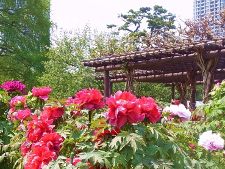 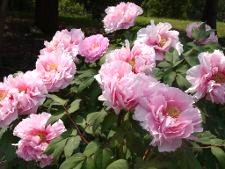
In late April, at the Botanen Garden in the Hamarikyu Garden, a peony called the "Hundred Flowers King" and "Kao" finally reached its best time.
The peony in the park is said to be about 800 plants of 60 species.
Peony is a deciduous Ogi of the Button family native to China.
Shakuyaku, the herb of the same family, blooms later.
From April to May, full of greenery, it is splendid to attach a large flower with a diameter of 20 cm, worthy of the name of the queen of garden trees. Also known as "Fukikusa" and "Fumigusa", and the English name is "Pionony".
It has a long history of breeding, and there are many variations of horticultural varieties.
There are various ways of blooming flowers, such as "single bloom", "double-flowered", "Senju bloom", "Manju bloom", "Head bloom", "Lion bloom", "Lion bloom".
The flower color is also rich in purple, red purple, black red, red (red), light red, white, and yellow, and "covering rings (the outer edge is bordered with a different color from the ground)" and "bottom red (the bottom of the petals) There are also flower patterns such as dark red) and "squeezing".
The most common flower season is "Spring Peony" of "Spring Bloom".
In addition, "two-season blooms" that blooms in winter and spring, usually removes the first buds formed in spring, cuts out leaves in summer, grows the second buds, and blooms from late autumn to winter. "Kan Peony" and
There is a "winter peony" that artificially adjusts the temperature of the "spring blooming" varieties and blooms from January to February.
In addition, "Botanhanasaku" is one of the 72nd weather.
It corresponds to the last weather of "grain rain" in twenty-four season old calendar, from April 30 to May 4.
    
    
[Shitamachi Tom]
April 21, 2014 16:00
Hamarikyu Garden is one of the most famous parks in Tokyo, but at this time, the "Hamarikyu Flower and Green Gathering" (until May 6) will be held, and residents of Chuo-ku will bring an admission numbered ticket It is a very good opportunity because you can enter for free.
 Just from April 19th (Sat) to 20th (Sun), an event called "Edo Bunkamura in Hamarikyu Garden" was held. It was sponsored by the Chuo-ku Shopping Street Federation, and also supported by the Chuo-ku Tourism Association. It is a plan to enjoy a beautiful holiday by touching food, play, and crafts while touching the emotions of the Edo period. Just from April 19th (Sat) to 20th (Sun), an event called "Edo Bunkamura in Hamarikyu Garden" was held. It was sponsored by the Chuo-ku Shopping Street Federation, and also supported by the Chuo-ku Tourism Association. It is a plan to enjoy a beautiful holiday by touching food, play, and crafts while touching the emotions of the Edo period.
At the event venue, attractions were held, exhibition booths of famous stores were lined up, and many customers visited. A booth of the Chuo-ku Tourism Association was also set up, and a happy voice was heard at the corner where you could experience "Throwing Fan".
 In the park, Satozakura is about to be watched, but the wisteria has begun to bloom, and the greenery of the trees has become even darker, and the scent of early summer seems to be filling at a stretch. Just this time, it is the transition from late spring to early summer, and while being wrapped in warm sunshine, sometimes chilly sea breezes flow from the sea, giving you a sense unique to this season. In the park, Satozakura is about to be watched, but the wisteria has begun to bloom, and the greenery of the trees has become even darker, and the scent of early summer seems to be filling at a stretch. Just this time, it is the transition from late spring to early summer, and while being wrapped in warm sunshine, sometimes chilly sea breezes flow from the sea, giving you a sense unique to this season.

A little more you will be able to enjoy hydrangea and Japanese iris too. It is a great place to enjoy the refreshing colors of this season.
The recommended walking course is to extend your legs to Ginza and Tsukiji on the way back and forth of Hamarikyu. One of the charms of Chuo-ku is that you can enjoy shopping and eating while wearing an urban atmosphere close to you after getting acquainted with the natural flowers.
It's been a good season! Please come and go out.
[Kenken]
April 20, 2014 09:00
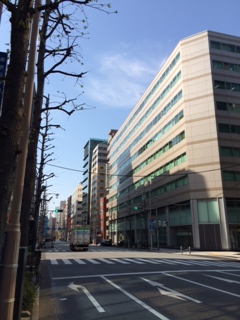
The neighborhood of Nihonbashi-Horidome-cho to Nihonbashi Ningyo-cho is located.
It is the area that started my life as a member of society.
I wanted to walk on this day, so I came here.
Ningyocho-dori, where the Hibiya Line runs underground.
As expected, there are few people around Kodemmacho on weekends to Horidomecho.
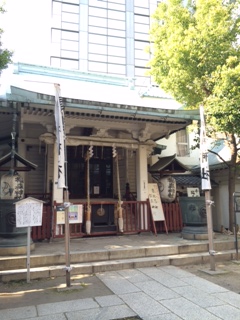
Enter a little street and head to "Sugimori Shrine" (1-10-2 Horidomecho).
This is one of the Nihonbashi Seven Lucky Gods, where Ebisu God is enshrined.
It is also known that the lottery industry was held for the purpose of renovating shrines and temples.
Thank you very much.
Chozuya was equipped with a sensor for water coming out soon. 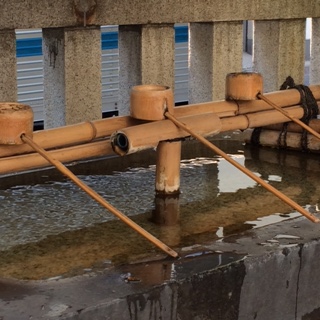
After the worship, you will see the surrounding area again.
In the surrounding area, signs of business partners who had been taken care of before were found everywhere, and I was deeply impressed by myself when I was a member of society after 20 years ago.
In the meantime, go to Koami Shrine (16-23 Koamicho), known for its "Good luck protection against misfortune." Of course, it's a corner of Nihonbashi Seven Lucky Gods.
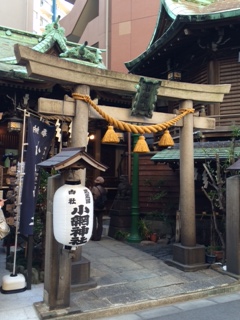
Inside, there was a Zen-washing Benten, and the space for Zen-washing was also clean.
I was able to wash the coins without any omission.
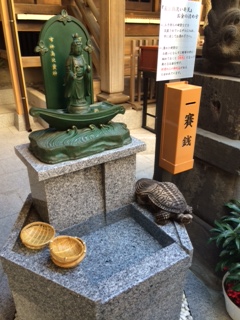 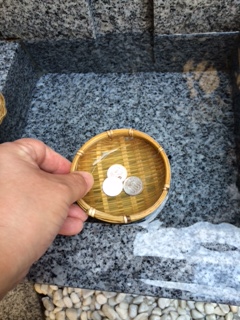
With this, you can connect hope to "Do you get better luck such as hitting a lottery?"
Well, I went to amazake Yokocho to buy souvenirs for my family.
The target for this day was "Inari Sushi Shinota" by "Shino Ta Sushi Sohonten" (2-10-10 Ningyocho).
The fried chicken is light (?) Seasoning. The first small Inari-san is an affordable size that can be eaten even in a bite.
Even before dinner, it was finished quickly.
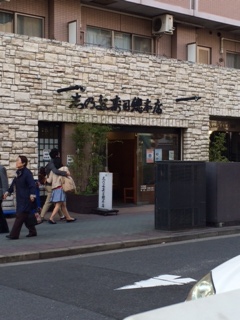 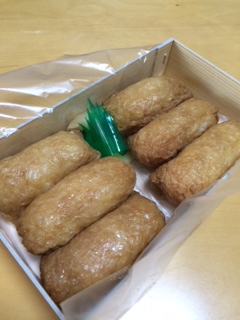
[Silver]
April 18, 2014 09:00
It was in the middle of April, and it was getting warmer.
The Tsukiji River Park is located between daily sports and St. Luke's College of Nursing.
In the warm sunlight, Hananoki attaches red sprouts and flowers.
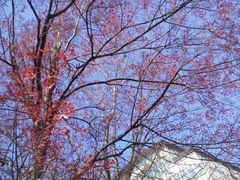
Cross the pedestrian crossing and move to the south, the flowers of pears are blooming.
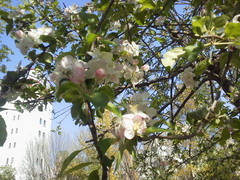
The laurel flowers are also in bloom. I saw this tree for the first time.
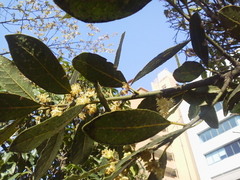
The flowers and azaleas of Chuo-ku are also blooming colorfully.
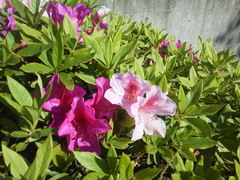
Let's go to Akashicho around "Japan's best bunsho Shiose".
Yae-zakura such as Sekiyama and turmeric are blooming.
Enjoy a walk in Tsukiji and Akashicho.
[Sam]
April 17, 2014 14:00
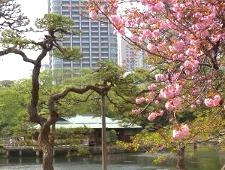 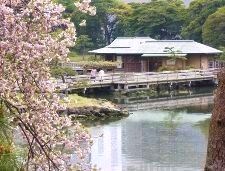
Following the Yoshino cherry tree, which was in full bloom at the end of last month, the so-called Yae-zakura, a group of so-called "Yaezakura", which is mainly planted on the lakeside from the "Oden Bridge" in the "Tide-filled Pond" to the "Ute-Oden Bridge".
As if the petals were folded in multiple layers and pink snow were piled up on the branches, the bells in full volume are gorgeous, giving a different taste from Yoshino cherry tree.
You can enjoy "multiple blooming" in different colors and shapes, as represented by the "five-colored Yae-zakura" of red (Sekiyama), light red (fugen elephant), white <light peach> (Kazuha), yellow (Utsukin), and green (Okin yellow).
It is said that there are about 100 cherry trees in the park (including about 10 in Yoshino cherry tree), but since it is not widely recognized as a famous spot for cherry blossoms, it is relatively vacant at this time, so you can take a leisurely stroll and look around.
The scenery that shines in the "tidal pond" against the background of "Ochiya in Nakajima" has a unique atmosphere.
After Great East Japan Earthquake in 2011, the lighting up is still canceled, but we are waiting for the revival of the stage setting where you can enjoy fantastic scenes.
In addition, on April 19 and 20, the garden will set up a food and beverage booth and a stage at Uchibori Square to taste the food culture reminiscent of Edo, touch products related to Edo, and enjoy Edo traditional performing arts. And enjoy the Edo atmosphere. "Edo Bunkamura in Hamarikyu Garden" hosted by the Chuo-ku Shopping Street Federation is scheduled to be held.
Red (Sekiyama) Thin red (fugen elephant) white <light peach> (Kazuha) yellow (Utsukin) Green (Yellow)
    
✎Sekiyama: A typical Yae-zakura variety that attracts attention with its bright red (dark pink) despite its many pale flower colors.
Shiozuke is used as Sakurayu.
Fugen Elephant: The elephant's nose (tusks) riding a Fugen Bodhisattva rides as two pistils turned into leaves from the center of the flower protrudes.
It is said to have been named after the 10th century. The flower color is light red.
Kazuha: It is said to have been named because a single pistil that has turned into leaf from the center of the flower protrudes.
The flower color is white to light pink.
Depression: The flower color resembles the yellow color of the coloring obtained from the rhizomes of the ginger family.
It is said to have been named.
Yellow: The flower color is (light) green at the time of flowering, gradually increasing yellow, and the center becomes red in a muscle shape.
It is said to have been named because of its image of the color of the noble noble costume.
[wombat]
April 11, 2014 16:00
On April 5, when the cherry blossoms are in full bloom, we boarded from Nitenmon after noon. For two and a half hours, I went around Odaiba and returned to Nitenmon again. A group of 15 people talk about cherry blossom viewing.
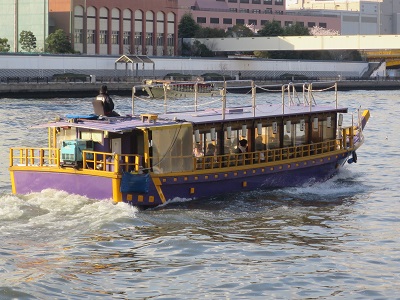
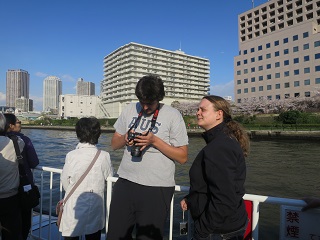 There were a lot of foreigners on board. There were a lot of foreigners on board.
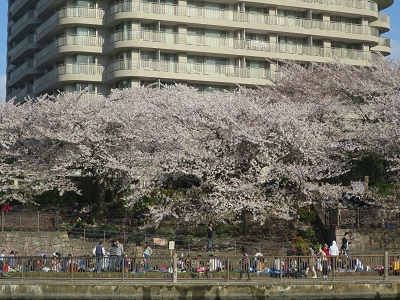
I looked at Tsukishima from the boat. A family is invited by the weather, and,
The weather was nice, so everyone went to see the cherry blossoms.
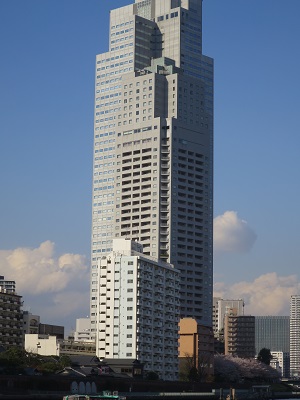 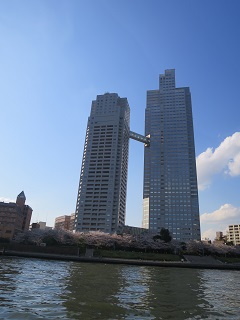
I took a picture of St. Luke's Garden from a different direction.
It looked like one, twins, and the cherry blossoms along the coast were wonderful.
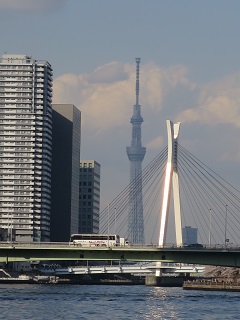 
I took a picture of the Sky Tree in a distant view on a different bridge. You know what bridge is.
 I'm happy if it's the right answer. I'm happy if it's the right answer.
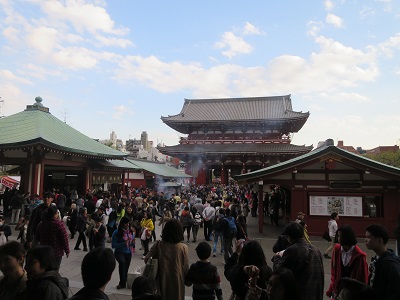 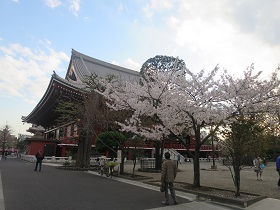 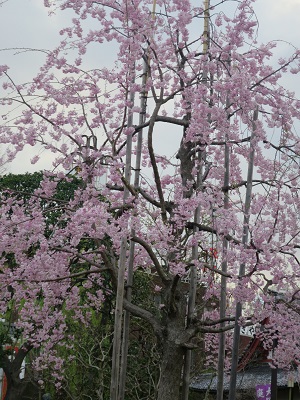
Finally, after disembarking, we stopped by Senso-ji Temple and went to the banquet.
weeping cherry tree? (Is it different from Kyoto?) It was a day to enjoy the cherry blossoms.
|
Links
|












 Just from April 19th (Sat) to 20th (Sun), an event called "Edo Bunkamura in Hamarikyu Garden" was held. It was sponsored by the Chuo-ku Shopping Street Federation, and also supported by the Chuo-ku Tourism Association. It is a plan to enjoy a beautiful holiday by touching food, play, and crafts while touching the emotions of the Edo period.
Just from April 19th (Sat) to 20th (Sun), an event called "Edo Bunkamura in Hamarikyu Garden" was held. It was sponsored by the Chuo-ku Shopping Street Federation, and also supported by the Chuo-ku Tourism Association. It is a plan to enjoy a beautiful holiday by touching food, play, and crafts while touching the emotions of the Edo period. In the park, Satozakura is about to be watched, but the wisteria has begun to bloom, and the greenery of the trees has become even darker, and the scent of early summer seems to be filling at a stretch. Just this time, it is the transition from late spring to early summer, and while being wrapped in warm sunshine, sometimes chilly sea breezes flow from the sea, giving you a sense unique to this season.
In the park, Satozakura is about to be watched, but the wisteria has begun to bloom, and the greenery of the trees has become even darker, and the scent of early summer seems to be filling at a stretch. Just this time, it is the transition from late spring to early summer, and while being wrapped in warm sunshine, sometimes chilly sea breezes flow from the sea, giving you a sense unique to this season.












